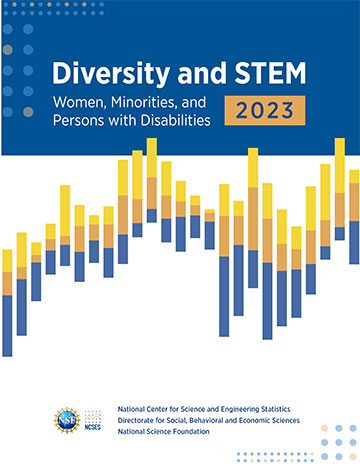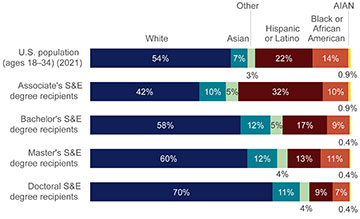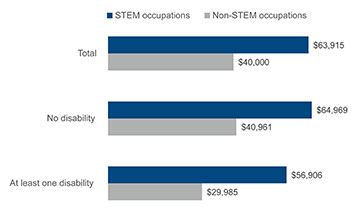
The cover of the 2023 US National Science Foundation’s National Center for Science and Engineering Statistics Diversity and STEM report. [Image: NSF NCSES]
On 30 January 2023, the National Center for Science and Engineering Statistics (NCSES), part of the US National Science Foundation (NSF), released the latest edition of a report entitled, “Diversity and STEM: Women, Minorities and Persons with Disabilities 2023.” Published every two years, as mandated by the Science and Engineering Equal Opportunities Act of 1980, it offers a detailed analysis of the representation of various groups in STEM employment and education in the United States.
The new report reveals that more women worked in STEM jobs and obtained degrees in science and engineering between 2011 and 2021, and that the same was true for Hispanic, Black, American Indian and Alaska Native people collectively. However, the report also shows that people in those groups—as well as people with disabilities—broadly remain underrepresented in STEM when compared with their overall proportions in the US population.
One notable difference in this year’s edition is the broadened definition of “STEM work,” says NCSES Director Emilda B. Rivers in a press release. For the first time, the report included STEM workers without a bachelor’s degree.
On the issue of gender
The 2023 report shows that over the past decade, the number of science and engineering degrees earned by women rose by 63% at the associate’s level, 34% at the bachelor’s level, 45% at the master’s level and 18% at the doctorate level. Despite these increases, however, there were still fewer women than men at all degree levels in physical, computer and earth sciences; mathematics; and engineering in 2020.
Science and engineering degree recipients, by degree level, race and ethnicity. (Data from 2020. AIAN stands for American Indian or Alaska Native. S&E stands for science and engineering.) [Image: “Diversity and STEM: Women, Minorities and Persons with Disabilities,” US National Center for Science and Engineering Statistics, National Science Foundation (2023)] [Enlarge image]
In addition, even though women make up half of the population, they represented just one-third of the STEM workforce in 2021. Women also received lower median earnings than men for jobs in or related to science and engineering and “middle-skill” jobs—defined as jobs that need considerable STEM skills and expertise but do not typically require a bachelor’s degree—in 2020. Men’s median earnings were US$100,000 for science and engineering jobs compared with US$76,000 for women.
Underrepresented groups
One of the most notable trends was the significant surge in the number of science and engineering degrees earned by Hispanic people, especially for associate’s degrees. Between 2011 and 2020, the number of such degrees awarded to Hispanic students tripled, bringing their share of STEM associate’s degrees to 32% of the total awarded to US citizens and permanent residents.
However, the overall underrepresentation of Hispanic, Black, American Indian and Alaska Native people continued in higher education. In 2021, these groups accounted for 31% of the US population. But they earned 26% of bachelor’s, 24% of master’s and 16% of doctoral STEM degrees awarded to US citizens and permanent residents in 2020.
Median earnings of the workforce between the ages of 18 and 74 in STEM and non-STEM occupations, by disability status. (Data from 2020.) [Image: “Diversity and STEM: Women, Minorities and Persons with Disabilities,” US National Center for Science and Engineering Statistics, National Science Foundation (2023)] [Enlarge image]
This lack of representation prevailed in the STEM workforce as well. Hispanic, Black, American Indian and Alaska Native people made up only 24% of science and engineering job-holders in 2021, and they tended to hold jobs that didn’t require bachelor’s or higher degrees. As a result, their median earnings were lower than those of white or Asian people with STEM occupations.
The data concerning people with disabilities showed mixed results. In 2021, people with one or more disabilities made up about 9% of the US population, while constituting 11% of STEM doctorate recipients but only 3% of the STEM workforce.
Strength in diversity
In the press release, NSF Director Sethuraman Panchanathan argued that diversity is a unique advantage for the United States when it comes to STEM. “Our global leadership depends upon diversity, leveraging different backgrounds, experiences and points of view to bring unique insights to problem solving and discovery,” he continued. “The Diversity and STEM report provides objective, reliable data on where our nation has made progress towards access and equity in STEM education and careers, as well as where we must do more.”



